|
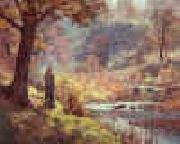 |
Theodore Clement Steele
|
|
1847-1926
Theodore Clement Steele Galleries
Theodore Clement Steele (September 11, 1847-July 24, 1926) was an American Impressionist painter known for his Indiana landscapes. Steele was born in Owen County, Indiana, and later moved to Indianapolis after study in Cincinnati, Chicago and Munich. He is considered to be the most important of the Hoosier Group of painters and his work is widely collected by museums and individuals. Steele earned his living primarily as a portrait painter and his portraits include one of notable Hoosier Poet James Whitcomb Riley and the official portraits of several Indiana governors. Steele exhibited at and was on the art selection for the Louisiana Purchase Exposition in 1904 and was elected to the National Academy of Design in 1913. He enjoyed plein air, or outdoor, painting, which is reflected in many of the landscapes he painted. Steele went through a notable change in style after his return from Munich in 1885. Steele's work, which in the Munich time period sported drab colors and high contrasts, shifted towards a brighter, more vivid color palette after his return to Indiana. Upon T.C. Steele's return, his family lived in the Talbot House, or Tinker Mansion, which is at what is now 16th and Pennsylvania Streets in Indianapolis. In 1898, Steele and J. Ottis Adams bought a home in Brookville, Indiana, which they called "The Hermitage." Steele sold his interest in the home to Adams after the death of his first wife.
He received an honorary master's degree from Wabash College in 1900 and an honorary doctorate from Indiana University in 1916. |
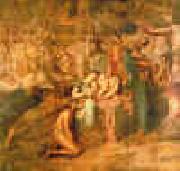 |
Theodore Chasseriau
|
|
1819-1856
French
Theodore Chasseriau Locations
1819?C56, French painter, b. Santo Domingo. He entered Ingres studio at the age of 12; five years later he gained immediate recognition with the exhibition of his Cain, Cursed and Return of the Prodigal. Chass??riau was the only artist of the age who successfully combined Ingres sense of line and Delacroix rich color and vitality and, at the same time, created his own personal style. After his visit to Algeria in the 1840s, he emphasized the exotic, romantic elements in his painting, while still adhering to classical techniques. Among his best-known works are the Two Sisters, Arabian Challenge, and Tepidarium (all: Louvre). His mural decorations for the Cour des Comptes of the Palais d Orsay, Paris, were destroyed except for a few fragments preserved in the Louvre. His untimely death cut short a brilliant career. |
 |
Theodore Gericault
|
|
French Romantic Painter, 1791-1824
Born in Rouen, France, Gericault was educated in the tradition of English sporting art by Carle Vernet and classical figure composition by Pierre-Narcisse Gu??rin, a rigorous classicist who disapproved of his student impulsive temperament, but recognized his talent.
The Charging Chasseur, 1812.Gericault soon left the classroom, choosing to study at the Louvre instead, where he copied from paintings by Peter Paul Rubens, Titian, Diego Vel??zquez, and Rembrandt for about six years, from 1810 to 1815. There he found a vitality which he preferred to the prevailing school of Neoclassicism. |
 |
Theodor Rocholl
|
|
(1854-1933), German military painter and war artist.
Rocholl was born in Sachsenberg (Waldeck) on June 11, 1854, the son of Rudolf Rocholl, the Lutheran theologian and philosopher. He was a student in Munich in 1877, then at the Dresden Academy. After a year, he moved to Munich where he studied historical painting under Karl von Piloty. He ocmpleted his art studies at the Desseldorf Academy where he developed his interest in military art under the influence of Wilhelm Camphausen; his contemporaries in this field were Carl Röchling and Richard Knötel. The artist observed the Franco-Prussian War and the subsequent German army manoeuvres between 1883 and 1888; in 1890, he traveled to Russia to view the German Garde-Korps on manoeuvre. Later in the decade, he was attached to the Turkish Army and covered the conflict in Thessalia in 1897 between the Turks and the Greeks; his sketches of the fighting were published the following year. He covered the Boxer Rebellion in 1900 as the official artist of the German expeditionary force. A decade later, he covered the fighting between Turkey and Albania.
Many of his paintings depict German military scenes, especially the battles of the Franco-Prussian War. One of his most famous pictures depicted King William at the Battle of Sedan, meeting his triumphant soldiers after the victory. Rocholl also painted a large mural for the Evangelischen Padagogiums in Bad Godesberg.
In his 60th year, he became a war artist covering the campaign on the Western Front. His War Letters printed in 1916 in which he described the fear and destruction. An autobiography of his life as a painter appeared in 1921. He died in a streetcar accident Desseldorf in his 80th year on September 14, 1933.
|
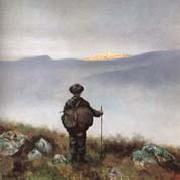 |
Theodor Kittelsen
|
|
1857-1914,was a Norwegian artist born in the coastal town of Kragero in Norway. He is famous for his nature paintings on the one hand, and on the other hand for his illustrations of fairytales and legends, especially of trolls. For a time, Kittelsen studied painting and watchmaking. When his talent was discovered by Diderich Maria Aall, he attended classes at the School of Art in Christiania (the present Oslo). Because of generous financial support by Aall he was able to continue his study in Munich. However, in 1879 Diderich Aall could no longer manage to support him, so Kittelsen had to earn his money as a draughtsman for German papers and magazines. When back in Norway, he found nature to be a great inspiration. Kittelsen started to write texts to his drawings here. In 1881, Kittelsen was hired to illustrate Norwegian fairy-tales by the Norwegian folklore collector Peter Christen Asbjornsen. His style could be classified between (Neo-)Romantic and naive painting. As a national artist he is highly respected and well known in Norway, but does not receive much international attention, which is the reason that his name is hardly registered in registers of painters. Black metal bands such as Burzum have used nearly all of his pictures as album art, notably illustrations taken from Kittelsen book Svartedauen (The Black Death). |
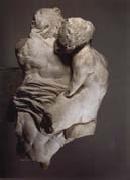 |
Theodor Kalide
|
|
1801 Konigshutte-1863 Gleiwitz,German sculptor. At the age of 15 he was apprenticed at the K?nigliche Eisengiesserei in Gleiwitz, where he soon began sculpting cast-iron plaques. In 1819 Johann Gottfried Schadow summoned him to Berlin, where he was instructed in chasing by Cou? and worked in the Berlin Eisengiesserei. In 1821 he transferred to the studio of Christian Daniel Rauch. Following Rauch's example and under his influence, Kalide produced such large animal sculptures as the Resting Lion and the Sleeping Lion (several casts, e.g. zinc, 1824; Berlin, Schloss Kleinglienicke). From 1826 to 1830 Kalide worked on equestrian statuettes, including those of Frederick William II (zinc), after the model by Emanuel Bardou (1744-1818), and Frederick William III (e.g. cast iron; both Berlin, Schloss Charlottenburg, Schinkel-Pav.). In 1830 he became a member of the Berlin Akademie. His most popular works included the life-size bronze group Boy with a Swan (1836), which was installed on the Pfaueninsel in Berlin as a fountain (several casts, all untraced). Kalide achieved wide recognition and aroused violent controversy with his almost life-size marble figure Bacchante on the Panther (1848; Berlin, Schinkelmus., badly damaged). This work transgressed the accepted boundaries of classical art, above all in the figure's provocative pose, and was perceived as shocking. In its uninhibited sensuality and its blending of the human and the animal, it offended the conservative Berlin public, and consequently Kalide received few new commissions. He had no success with competition designs and became increasingly embittered. He spent his last years at Gleiwitz, where he died. |
 |
Theodor Hosemann
|
|
painted Blick uber die Havel auf das winterliche Brandenburg in 1838 |
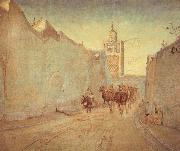 |
Theodor Esbern Philipsen
|
|
1840-1920
Danish painter, sculptor and draughtsman. He studied at the Kongelige Akademi for de Skenne Kunster, Copenhagen, in 1862-3 and 1865-9, and in Paris under Leon Bonnat in 1875-6. He was an important figure in the development and renewal of Danish naturalism, linking the Danish Golden Age tradition with new French ideas. Conscious of the importance of plein-air painting, he was first a great admirer of the Barbizon school; later he was influenced by the Impressionists, becoming the only truly Danish Impressionist. Frequent visits abroad helped him develop his outlook; he eagerly studied the Old Masters, and the strong light of the south
|
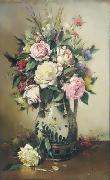 |
Theodor Aman
|
|
Theodor Aman (Romanian pronunciation: [teˈodor aˈman]; 20 March 1831, Câmpulung-Muscel-19 August 1891, Bucharest) was a Romanian painter of Armenian descent. His style is often considered to be a predecessor of Impressionism.
He is buried in Bellu cemetery.
|
 |
theodor alt
|
|
(Januar 1846 in Döhlau bei Hof (Oberfranken); 8. Oktober 1937 in Ansbach) war ein deutscher Maler.
Alt war der Sohn des Döhlauer Pastors Heinrich Alt und dessen Ehefrau Justina Ziegler. Nach erstem Unterricht durch seinen Vater besuchte Alt die Lateinschule in Regensburg, wo sein Vater von 1856 bis 1870 der evangelischen Gemeinde vorstand.
1861 wechselte er an die Kunstgewerbeschule N??rnberg, wo er als Schuler von Hans Ringlein bis 1863 blieb. Im Spatsommer desselben Jahres wechselte Alt mit Empfehlung seiner Lehrer an die Kunstakademie in M??nchen. Dort wurde er zuerst Sch??ler von Hermann Ansch??tz und in den Jahren 1866 bis 1873 bei Arthur von Ramberg. |
 |
Theodoor Rombouts
|
|
Flemish , b. 1597, Antwerpen, d. 1637, Antwerpen
was a Flemish Baroque painter specializing in Caravaggesque genre scenes of card players and musicians. He studied under Abraham Janssens in Antwerp and was in Italy between 1616 and 1625, where he was heavily influenced by Caravaggio. |
 |
Theobald Michau
|
|
Michau (1676 Tournai - Antwerp 1765) was a conservative Flemish painter of landscapes, more famous in his own time than he is today. He was a pupil of Lucas Achtschellinck.
Subjects of the country festivals (Kermesse) that were popularized by David Teniers, father and son to the extent that paintings and tapestries showing such rustic themes were called Tenieres. Michau painted designs and perhaps provided full-scale cartoons for tapestry weavers, for surviving records of the Brussels tapestry workshop of Pieter van der Borcht record Teniers peints par le fameux Sr Michau, such Teniers-like subjects painted by "the famous Sieur Michau".
Among his work, on wooden or copper panels, in public collections are the Summer and Winter landscapes in Vienna
|
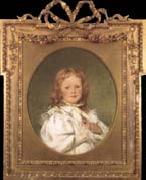 |
Theobald Chartran
|
|
French Academic Painter, 1849-1907, He was a classical French academic painter. As 'T', he was one of the artists responsible for occasional caricatures of Vanity Fair magazine, specializing in French and Italian subjects. His work for Vanity Fair included Pope Leo XIII, Giuseppe Garibaldi, Umberto I of Italy, William Henry Waddington, all in 1878, Charles Gounod, Giuseppe Verdi, Ernest Renan, Jules Grevy, Napoleon Joseph Charles Paul Bonaparte, Victor Hugo, Marshal MacMahon, Granier de Cassagnac, Louis Blanc, and Alexandre Dumas, Fils, all in 1879. |
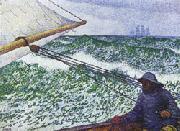 |
Theo Van Rysselberghe
|
|
Belgian Pointillist Painter, 1862-1926
was a Belgian neo-impressionist painter, who played a pivotal role in the European art scene at the turn of the century. Born in Ghent to a French-speaking bourgeois family, he studied first at the Academy of Ghent under Theo Canneel and from 1879 at the Academy of Brussels under the directorship of Jean-François Portaels. The North African paintings of Portaels had started an orientalist fashion in Belgium. Their impact would strongly influence the young Theo van Rysselberghe. Between 1882 and 1888 he made three trips to Morocco, staying there a total of one year and half. Barely 18 years old, he already participated at the Salon of Ghent, showing two portraits. Soon afterwards followed his Self-portrait with pipe (1880), painted in somber colours in the Belgian realistic tradition of that time. His Child in an open spot of the forest (1880) already departs from this style and he sets his first steps towards impressionism. |
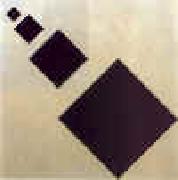 |
Theo van Doesburg
|
|
Dutch
1883-1931
Dutch painter, architect, designer and writer. He was officially registered as the son of Wilhelm Kepper and Henrietta Catharina Margadant, but he was so convinced that his mother second husband, Theodorus Doesburg, was his father that he took his name. Little is known of his early life, but he began painting naturalistic subjects c. 1899. In 1903 he began his military service, and around the same time he met his first wife, Agnita Feis, a Theosophist and poet. Between about 1908 and 1910, much influenced by the work of Honor Daumier, he produced caricatures, some of which were later published in his first book De maskers af! (1916). Also during this period he painted some Impressionist-inspired landscapes and portraits in the manner of George Hendrik Breitner. Between 1914 and 1915 the influence of Kandinsky became clear in such drawings as Streetmusic I and Streetmusic II (The Hague, Rijksdienst Beeld. Kst) and other abstract works. |
 |
th. hildebrandt
|
|
Ferdinand Theodor Hildebrandt, född 2 juli 1804 i Stettin, död 29 september 1874 i Dusseldorf, var en tysk målare.
Hildebrandt började sina konstnärliga studier i Berlin under Wilhelm Schadow, vilken han 1826 följde till Dusseldorf, och blev en av den där grundade skolans mest framstående lärjungar. 1825 framträdde han med Faust, 1826 med Cordelia och kung Lear och 1828 med Tankred döpande Klorinda. Ännu större popularitet vann han 1835 för Mordet på kung Edvards söner. Bland hans genrebilder har i synnerhet Krigaren och hans son (1832, Berlins nationalgalleri) blivit känd. Hildebrandt, som för övrigt utförde illustrationer och porträtt, kallades på sin tid realist, men han var knappast fri från den melodramatiska ton och den sentimentala inställning, som tillhörde skolan. |
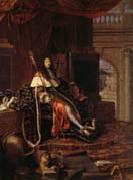 |
Testelin,Henri
|
|
French , 1616-1695
Painter, printmaker and writer, brother of Louis Testelin. As a member of the circle of Charles Le Brun, he endorsed his connection with the Academie Royale by submitting an allegorical portrait of Louis XIV in Childhood as Patron of the Arts as his morceau de reception. He was secretary of the Acad?mie from 1650 and a professor from 1656. He produced several tapestry cartoons based on designs by Le Brun for the Gobelins, including the Wedding of Louis XIV and Maria-Theresa on 9 June 1660 (before 1665) and the Founding of the Academie des Sciences and the Observatory in 1666. He was active also as a court portrait painter, exhibiting portraits of Louis XIV as Patron of the Academie Royale de Peinture et de Sculpture (exh. Salon 1673; Versailles, Cheteau) and of Maria-Theresa, Queen of France . Also at the Salon of 1673 he showed a history painting, |
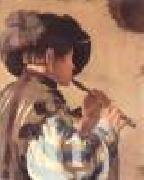 |
TERBRUGGHEN, Hendrick
|
|
Dutch Baroque Era Painter, ca.1588-1629
Dutch painter, a leading member of the Utrecht school. He was a pupil of the history painter Bloemaert before living (c.1604?C14) in Italy. Crowning of Thorns (1620; Copenhagen) is his first known dated work. Like his contemporaries Honthorst and Baburen, he was largely influenced by Caravaggio, although an awareness of D??rer and Lucas van Leyden recurs throughout his work. His intimate and restrained genre compositions foreshadow in coloring the work of Vermeer. Many of Terbrugghen's paintings are nighttime genre scenes. His work is represented in the major European museums. Typical examples are his St. Sebastian (Allen Mus., Oberlin, Ohio), Old Man Writing |
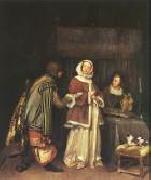 |
TERBORCH, Gerard
|
|
Dutch Baroque Era Painter, 1617-1681
Dutch genre and portrait painter. He studied with his father and traveled throughout Europe, showing extraordinary precocity in his early work. In 1648 he attended the congress at Menster and painted portraits of the delegates that he incorporated in his celebrated group, The Peace of Menster (National Gall., London). Soon after, he was invited to Spain, where he worked for Philip IV. On returning to Holland in 1650 he painted a variety of genre scenes, capturing the individuality of each subject and portraying the life and customs of the wealthy burgher class with rare dignity and distinction. The tiny portraits and the interiors that were his specialty are painted with elegance, serenity, and a technique of consummate craftsmanship. Among his most famous pictures are Self-Portrait and The Toilet (The Hague), and The Guitar Lesson (National Gall., London). |
 |
Teofil Kwiatkowski
|
|
(February 21, 1809, Pułtusk - August 14, 1891, Avallon, France) was a Polish painter.
Kwiatkowski participated in the November 1830 Uprising. After its suppression, he emigrated to France.
His artistic work includes many images of Frederic Chopin, including a picture of him playing at a ball at Paris's Hôtel Lambert and Chopin on His Deathbed (1849).
|
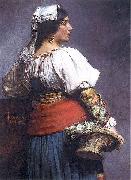 |
Teodor Axentowicz
|
|
born May 13, 1859 in Braşov, Romania - August 26, 1938 in Krakew) was a Polish-Armenian painter and university professor. A renowned artist of his times, he was also the rector of the Academy of Fine Arts in Krakew. As an artist, Axentowicz was famous for his portraits and subtle scenes of Hutsul life, set in the Carpathians.
Axentowicz was born May 13, 1859 in Braşov, Hungary (now Romania), to a family of Polish-Armenian ancestry. In 1893 in Chelsea, London, he married Iza Henrietta Gielgud, aunt of Val Gielgud and John [Arthur] Gielgud of the theatrical dynasty. A son, Philip S.A.D. Axentowicz was born in Chelsea in 1893.
Between 1879 and 1882 he studied at the Academy of Fine Arts in Munich. From there he moved to Paris, where he continued his education until 1895. During that time he started a long-time cooperation with various journals and started his career as a copyist, duplicating the works of Tizian and Botticelli. He also made numerous travels to London and Rome, where he prepared a set of portraits, one of the first in his career.
|
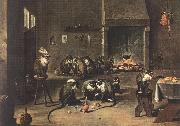 |
TENIERS, David the Younger
|
|
Flemish Baroque Era Painter, 1610-1690
a Flemish artist born in Antwerp, was the more celebrated son of David Teniers the Elder, almost ranking in celebrity with Rubens and Van Dyck. His son David Teniers III and his grandson David Teniers IV were also painters. His wife Anna nee, Anna Breughel was the daughter of Jan Brueghel the Elder and the granddaughter of Pieter Bruegel the Elder. Through his father, he was indirectly influenced by Elsheimer and by Rubens. The influence of Adriaen Brouwer can be traced to the outset of his career. There is no evidence, however, that either Rubens or Brouwer interfered in any way with Teniers's education, and Smith (Catalogue Raisonn) may be correct in supposing that the admiration which Brouwer's pictures at one time excited alone suggested to the younger artist his imitation of them. The only trace of personal relations having existed between Teniers and Rubens is the fact that the ward of the latter |
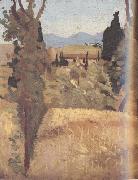 |
Telemaco signorini
|
|
Italian Painter, 1835-1901
was an Italian artist who belonged to the group known as the Macchiaioli. He was born in the Santa Croce quarter of Florence, and showed an early inclination toward the study of literature, but with the encouragement of his father, Giovanni Signorini, a court painter for the Grand Duke of Tuscany, he decided instead to study painting. In 1852 he enrolled at the Florentine Academy, and by 1854 he was painting landscapes en plein air. The following year he exhibited for the first time, showing paintings inspired by the works of Walter Scott and Machiavelli at the Florentine Promotrice. In 1855, he began frequenting the Caffe Michelangiolo in Florence, where he met Giovanni Fattori, Silvestro Lega, and several other Tuscan artists who would soon be dubbed the Macchiaioli. The Macchiaioli, dissatisfied with the antiquated conventions taught by the Italian academies of art, started painting outdoors in order to capture natural light, shade, and color. They were forerunners of the Impressionists who, beginning in the 1860s, would pursue similar aims in France. Signorini was a volunteer in the Second Italian War of Independence in 1859, and afterwards painted military scenes which he exhibited in 1860 and 1861. He made his first trip outside Italy in 1861 when he visited Paris, to which he would often return in the decades that followed. There he met Degas and a group of expatriate Italian artists in his orbit, including Giovanni Boldini, Giuseppe De Nittis, and Federico Zandomeneghi; unlike them, however, Signorini remained rooted in Italy. He became not only one of the leading painters of the Macchiaioli, but also their leading polemicist. Art historian Giuliano Matteucci has written: "If we acknowledge Fattori and Lega as the major creative figures of the macchiaioli, then Signorini must surely be recognized as their 'deus ex machina'", |
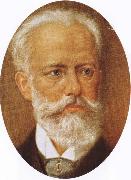 |
tchaikovsky
|
|
Born: 7 May 1840
Birthplace: Votkinsk, Russia
Died: 6 November 1893
Best Known As: Russian composer of The Nutcracker |
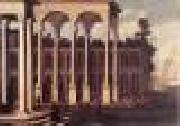 |
TASSI, Agostino
|
|
Italian painter, Roman school (b. 1578, Roma, d. 1644, Roma).
|
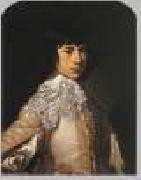 |
TASSEL, Jean
|
|
French Baroque Era Painter, ca.1608-1667
Son of Richard Tassel, with whose works his own were for a long time confused. He trained with his father and by 1634 was recorded in Rome, where he came into contact with his fellow Frenchmen Claude Lorrain, Nicolas Poussin and Sebastien Bourdon. Like the last he was influenced by the Bamboccianti, and he painted a number of low-life genre scenes at this period; these include Singers in a Tavern (Kassel, Schloss Wilhelmshehe) and Travellers Attacked (Warsaw, N. Mus.). He had returned to Langres by 1647, the date of his marriage, and continued to paint genre pictures after this, such as The Sawyers (Strasbourg, Mus. B.-A.) and The Marauders (Langres, Mus. St Didier). Other influences from Rome include Caravaggio, strong in a picture such as the Fortune-teller (sold Paris, Drouot, 1 April 1987, ) but far less apparent in the Presentation of the Infant Jesus (Dijon, Mus. B.-A.) and Tobias and the Angel (Dijon, Mus. B.-A.). However, the most lasting influence was that of the Romano-Bolognese school, seen in later pictures such as the Annunciation |
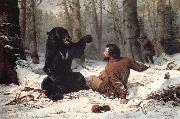 |
Tait Arthur Fitzwilliam
|
|
English-born American Painter, 1819-1905
American painter and lithographer of English birth. He spent the first three decades of his life in England and arrived in New York in 1850. Steeped in admiration for the subjects of Edwin Landseer and the style of the Pre-Raphaelites, he established himself as a realistic painter of animals and sporting scenes. For his images of Western hunters and trappers, he used as sources the works of George Catlin and William Ranney, artists who, unlike himself, had travelled extensively. He established a summer studio at a camp in the Adirondack Mountains, where he painted sporting scenes. These wilderness scenes, often composed around an anecdote, appealed to a wide popular audience, and from 1852 Currier & Ives as well as Louis Prang published a number of lithographs and chromolithographs of his work. Tait also composed still-lifes of game birds and, in his later career, barnyard scenes of sheep and chickens. His painting A Tight Fix: Bear Hunting in Early Winter |
 |
Tadeusz Makowski
|
|
(21 January 1882 - 1 November 1932) was a prominent Polish painter active in France for most of his life. He was born in Oświęcim. Makowski attended the Academy of Fine Arts in Krakew. He studied under Jan Stanisławski and Jezef Mehoffer. In 1909, he departed for Paris. Makowski started off as a landscape painter but then shifted towards Post-Impressionism and Cubism. However, he is arguably most famous for his rural landscape paintings. He met Pablo Picasso,who was his good friend.
|
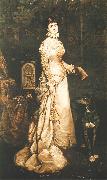 |
Tadeusz Ajdukiewicz
|
|
1852 in Wieliczka ?C January 9, 1916 in Krak??w) was a Polish painter.
From 1868 to 1873, he followed Władysław Luszczkiewicz classes in the Fine art school of Krakow. Later, he was in Vienna and Munich and in J??zef Brandt's atelier. In 1877, he travelled to Paris and Near East. In 1882, he lived in Vienna, where he worked for the aristocracy. In 1883, he went to London, where he made Prince of Wales' portrait. In 1884, to Constantinople, he was sultan Abdhulhamid II's guest. And he woked later in Sofia, Saint Petersburg and Bucharest. He joined the Polish Legions in 1914, during World War I, and he died in one of the battles of this war. He's first cousin was Zygmunt Ajdukiewicz. |
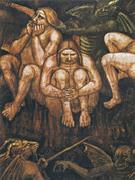 |
Taddeo di Bartolo
|
|
Italian Gothic Era Painter, ca.1362-1422
Italian painter. Taddeo, son of the barber Bartolo di Mino, was under 25 in 1386 when he was first recorded, painting statuettes of angels for the new choir-stalls in Siena Cathedral. In 1388-9 he was a counsellor to the Cathedral Works and in 1389 he was first listed as an independent painter. His earliest dated work is the polyptych of the Virgin and Child with Saints (1389; sold London, Christie's, 8 Dec 1950), painted for the chapel of S Paolo at Collegarli, near San Miniato al Tedesco. |
 |
Stefano Torelli
|
|
Bologna 1712-St Petersburg 1784
was an Italian painter. He was born in Bologna. He studied first under his father, Felice Torelli, and then under Francesco Solimena. The future King of Poland, Augustus III, brought him to Dresden in 1740, where he painted altar-pieces and ceiling decorations, many destroyed in the Seven Years' War. He painted figures in Canaletto's twenty-nine views of Dresden (1741). In 1762 he was summoned to the Russian court where he painted ceilings in the Royal Palace, and some portraits, among the latter one of the Empress Elizabeth in armor. He was a clever caricaturist, and etched a few plates. He died in St. Petersburg. |
 |
Sir Thomas Lawrence
|
|
1769-1830
British
Sir Thomas Lawrence Galleries
was a notable English painter, mostly of portraits.
He was born in Bristol. His father was an innkeeper, first at Bristol and afterwards at Devizes, and at the age of six Lawrence was already being shown off to the guests of the Bear as an infant prodigy who could sketch their likenesses and declaim speeches from Milton. In 1779 the elder Lawrence had to leave Devizes, having failed in business and Thomas's precocious talent began to be the main source of the family's income; he had gained a reputation along the Bath road. His debut as a crayon portrait painter was made at Oxford, where he was well patronized, and in 1782 the family settled in Bath, where the young artist soon found himself fully employed in taking crayon likenesses of fashionable people at a guinea or a guinea and a half a head. In 1784 he gained the prize and silver-gilt palette of the Society of Arts for a crayon drawing after Raphael's "Transfiguration," and presently beginning to paint in oil.
|
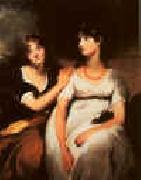 |
Sir Thomas Lawrence
|
|
1769-1830
British
Sir Thomas Lawrence Galleries
was a notable English painter, mostly of portraits.
He was born in Bristol. His father was an innkeeper, first at Bristol and afterwards at Devizes, and at the age of six Lawrence was already being shown off to the guests of the Bear as an infant prodigy who could sketch their likenesses and declaim speeches from Milton. In 1779 the elder Lawrence had to leave Devizes, having failed in business and Thomas's precocious talent began to be the main source of the family's income; he had gained a reputation along the Bath road. His debut as a crayon portrait painter was made at Oxford, where he was well patronized, and in 1782 the family settled in Bath, where the young artist soon found himself fully employed in taking crayon likenesses of fashionable people at a guinea or a guinea and a half a head. In 1784 he gained the prize and silver-gilt palette of the Society of Arts for a crayon drawing after Raphael's "Transfiguration," and presently beginning to paint in oil.
|
|

